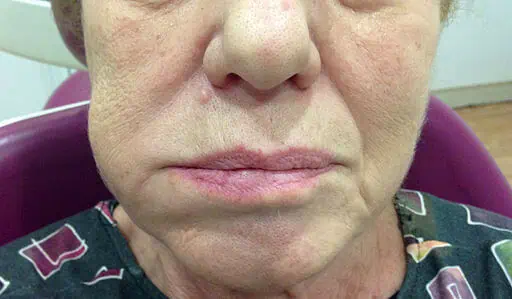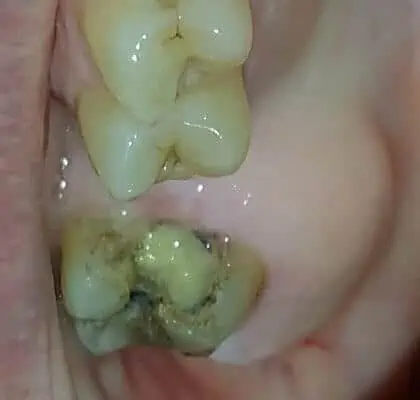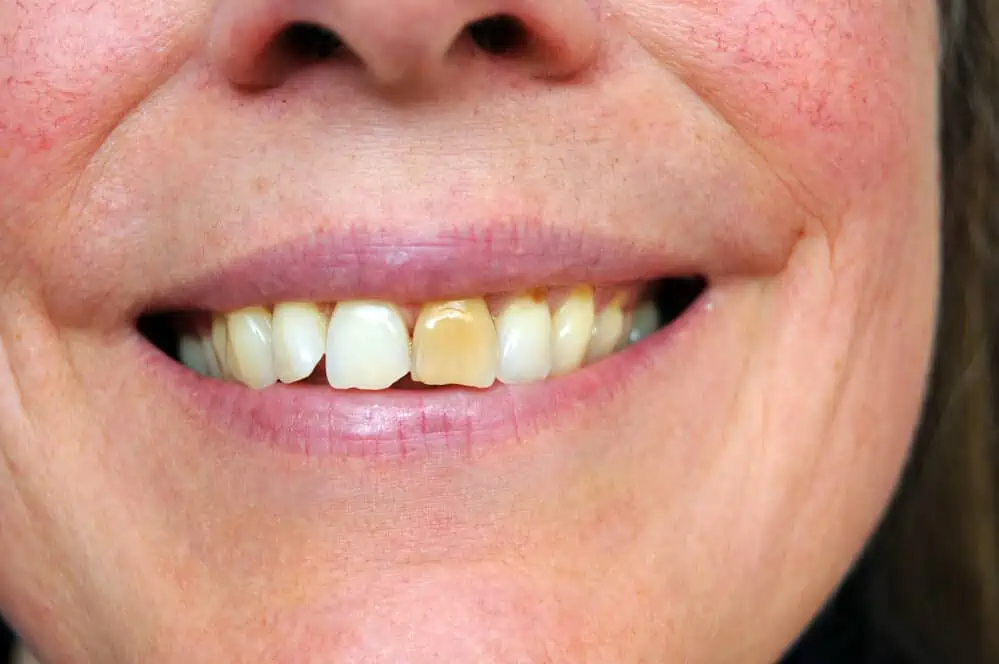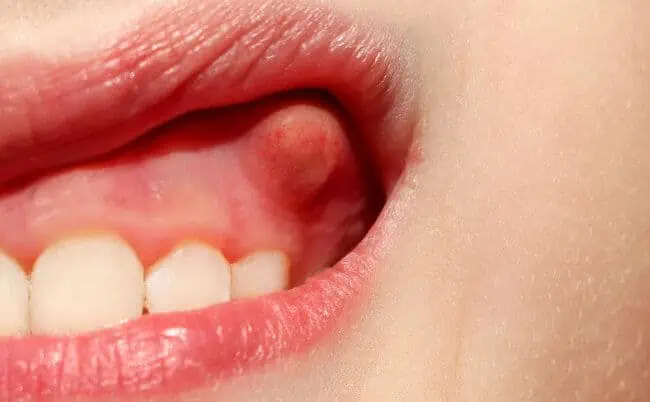Are you worried you might have a tooth abscess? Perhaps someone you know has an abscess in their mouth and you want to know what exactly that means, and how you can avoid a similar tooth infection.
In this article, we'll explain what causes gum boils and infections, how to spot tooth abscess symptoms, and what dental abscess treatment usually involves.
We'll also give you some tips for avoiding an abscessed tooth in the first place. It's worth following this advice to reduce your chances of a painful infection and uncomfortable treatment.
Would you like to speak to a dentist right now about your problem? You can chat online with a dentist and get an answer to your question – often within minutes – by visiting JustAnswer. All their dentists are based in the US and are fully qualified. Tell them about your situation and they will be able to advise you on the best course of action.
If you're in real pain and don't have time to read this whole article, call NHS111 for advice on what to do.
In This Article
What is a tooth abscess?


An abscess is a pocket of pus that accumulates when a bacterial infection breaks down tissue. Abscesses can form in many different parts of the body, including in the mouth.
They are a natural defence mechanism, the aim being to block the infection from reaching other areas. The resulting build-up of pus is usually very painful due to the pressure this fluid exerts on nerve endings.
When it comes to mouth abscesses, both the gums and the teeth themselves are at risk. An abscess in the mouth can erode the periodontal structure (which supports the teeth) and the jaw bone, causing irreparable damage. In some cases, the affected tooth has to be extracted.
By understanding tooth abscess symptoms and seeking professional treatment as soon as you become concerned, you can reduce the chances of further infection and complications or other oral health problems.
What does an abscessed tooth look like?
If you think you may have an abscess, you might be searching for tooth abscess pictures so you can check your symptoms. Keep in mind that not all abscesses are externally visible, so don't be put off visiting your dentist just because you can't see any outward signs of infection in your mouth.
While some dental abscesses may appear as small lumps inside the mouth (as in the image below), they may also result in much greater swelling either in the mouth or on the face. If you have a swollen face and oral pain, a tooth abscess may be the cause.
Tooth abscess stages pictures
If you're curious to know what an abscess in the mouth can look like, below you'll find some tooth and gum abscess stages pictures. These show the internal and external symptoms of a tooth infection that's resulted in an abscess.
External symptoms | Internal symptoms |
|
|
Facial swelling | Swelling around a molar |
| 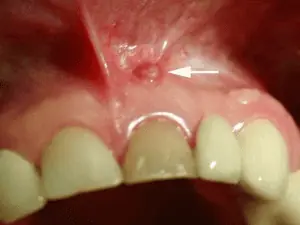  |
Swollen lymph nodes | Hole in the roof of the mouth |
|
|
Discoloured tooth | Child gum abscess |
Remember, even if your mouth doesn't look exactly like this, you should still visit a dentist if you're worried.
Types of dental abscess
There are three main types of mouth abscesses: gingival, periodontal and periapical. The distinguishing factor for each one is the location where the abscess forms.
Gum abscess (Gingival abscess)
A gingival abscess, or gum abscess, forms on the surface of the tissue at the gum line of the teeth (gingiva). This is often a result of external damage to the gum, for example from food entering the gumline or penetration from a toothpick.
If caught early, an abscess on the gum is relatively easy to treat and recover from. If left untreated, however, a gum boil can progress to a periodontal abscess and cause greater oral damage.
Periodontal abscess
A periodontal abscess occurs deeper into the gum pockets. Since there is nowhere for pus to drain, the abscess spreads into the surrounding tissue and jaw bone.
Periapical abscess
These begin in the soft tooth pulp, usually as a result of decay deep inside the tooth. Once tooth decay has eroded the protective enamel and dentin of the tooth, bacteria can invade the nerves and tooth pulp (a condition known as pulpitis).
Pus from this mouth infection may appear at the gum line of the tooth, but more commonly it ends up in surrounding tissue which becomes inflamed.
Wisdom tooth abscess
A common type of periapical abscess is a wisdom tooth abscess, since the very back teeth are harder to clean so are more susceptible to infection. In addition, it's harder for your dentist to spot cavities on these teeth and treat them early on.
What causes an abscessed tooth?
Your mouth naturally contains bacteria, and when not cleaned well this forms plaque on your teeth and gums. Teeth infections develop when the acid produced by plaque starts to decay the teeth, reaching the pulp tissue and spreading to the tissues around the root.
The main tooth abscess cause is untreated tooth decay that's left to spread. Other possible reasons for infection include:
- Gum disease (gingivitis)
- A cracked tooth
- Trauma
- Complications from dental surgery such as implants, root canal treatment and extractions
- Rough tooth brushing or flossing
- Food stuck between teeth and gums
People with poor dental hygiene are more susceptible to dental abscesses due to an increased build-up of plaque. Any injury or surgery to teeth and gums can increase the chances of infection as sterile parts of the mouth are exposed to bacteria.
In addition, people with a weakened immune system are at greater risk of developing a dental infection. The immune system is affected by certain underlying health conditions, such as diabetes. Some medical treatments, such as chemotherapy, also reduce a patient's natural immunity.
While none of these things will automatically lead to a tooth or gum abscess, they are all factors which increase the risk of infection.
Tooth abscess symptoms
The first signs of tooth infection are likely to be strong pain and difficulty eating. Specifically, tooth infection symptoms include:


- Unbearable pain at night that prevents you from sleeping
- Painful lymph nodes
- Facial asymmetry
- Continuous, throbbing pain
- Pain when the tooth is tapped
- Increased pain when eating hot or cold foods/drinks
- Greater discomfort when biting teeth together or chewing food
- A foul, bitter taste in the mouth from draining pus
- A bad smell in the mouth from the infection
- Swelling and reddening of the face or gums
- Bleeding from the gums
- A tooth that is loose and/or discoloured
- A pea-sized bump on the gums or pimple inside the mouth
More serious symptoms which may indicate dental abscess complications include:
- Fever
- Headache
- Nausea
- Diarrhoea
- Swollen lymph nodes
- Pain spreading to the jaw, ear or neck on the same side as the infected tooth
- Difficulty opening your mouth (trismus)
- Difficulty breathing or swallowing (dysphagia)
- General fatigue
These dental abscess symptoms usually come on quite suddenly. Within a few hours, you may find yourself in excruciating pain. The same symptoms apply to tooth infections in children.
Tooth abscess pain can be extreme, but you shouldn't consider pulling your own tooth to stop it. An urgent dentist visit is a much better idea.
Note that patients can experience an initial toothache which then fades away. It's easy to assume that the problem is fixed, but this is not the case. Your tooth pulp cannot heal itself, but once the nerve is destroyed you won't experience any pain.
It's only once the infection has spread through the dead tooth into the surrounding gums and tissue that symptoms will re-appear. At this point, far more extensive damage has been done.
To avoid tooth abscess complications, you should visit a dentist as soon as you notice any tooth infection symptoms, even if they disappear by themselves.
If you're having trouble finding a dentist right now, you can chat to a dentist online using JustAnswer. Their team of US-based dentists are available to answer your questions and discuss your tooth abscess symptoms.
Acute vs. chronic abscess
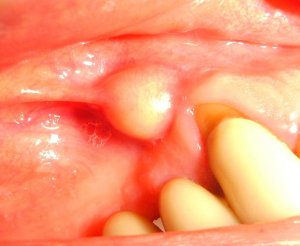

The above symptoms are all characteristic of what is called an acute abscess. This spreads fast and usually causes great discomfort and pain for the patient.
A chronic abscess, on the other hand, grows slowly and may cause no pain whatsoever. The patient is therefore unaware of the presence of the abscess, and only a dental x-ray will be able to identify it. This is usually a periapical abscess, spreading gradually through the tooth root and into the surrounding tissue.
Eventually, the pus may create a tunnel through the bone and tissue, known as a ‘fistula' or ‘sinus tract'. This allows the pus to drain and looks like a pimple inside your mouth.
If you see or feel something like this in your mouth, even if you haven't experienced any other tooth abscess symptoms, you should consult your dentist. If pus starts to drain through the fistula, you'll know about it from the foul taste.
Tooth abscess treatment
Dental abscess pain can be intense and prevent the patient from eating properly. In this case, it may be appropriate to seek emergency dental treatment. Even if the pain is bearable, you should visit a dentist as soon as possible to avoid further damage and complications.
If you're having difficulty breathing or swallowing, or have a fever or facial swelling, call 999 or get straight to A&E. These are signs that the infection has spread further into your jaw and you need urgent treatment.
Gum abscess drainage
How do you get rid of an abscessed tooth? The first priority with any dental abscess treatment is to drain the pus that has built up and remove the source of the infection. How to drain the tooth abscess will depend on the type of abscess you have.
Your dentist may begin by taking an x-ray to determine how far the abscess has spread and what kind of treatment is needed.
Gum abscess treatment is relatively straightforward. It may be possible to release the pus and drain the gingival abscess by applying gentle pressure, just as you would with a pimple on your skin. The dentist will then use a small probe to scrape the remaining infected material from inside the abscess.
In other cases, the dentist may have to make a small incision in the gum boil to access the infected area. Provided the infection hasn't spread into the periodontal structure, no further treatment will be required, although antibiotic treatment may aid recovery.
If you have a gum abscess that ruptures by itself, you may find that the pain subsides significantly when the pressure is released. However, this doesn't mean the infection has cleared. You should still visit your dentist to have the area cleaned properly.
Where a fistula has formed on the gum because of a periodontal abscess, the dentist will insert a thin probe into the hole. They will then take an x-ray (with the probe still in place), and from this, they can see the original source of the infection.
Root canal treatment for abscessed teeth
Periapical abscesses can often be treated with a root canal. This involves drilling down through the crown of the tooth to access the infected pulp chamber. The dentist drains the pus from the abscess, cleans and disinfects the cavity, and applies a filling material.
The infection destroys some of the tooth structure making the tooth weaker. In addition, the process of root canal treatment and properly cleaning and disinfecting the roots requires the removal of all the infected tissue, so a dental crown is necessary after a root canal treatment to protect the tooth and prolong its life.
Read more about the root canal procedure, or watch this short video to see how it is conducted:
Gum abscess complications leading to extraction
In the case of periapical and periodontal abscess treatment, if the infection has spread into the jaw bone or periodontal ligament it may be necessary to extract one or more teeth. Extraction is a last resort, though, and will only be done if the dentist judges the bone to be too far eroded to support the teeth.
With periodontal abscess treatment, the dentist will first carry out a deep cleaning of the gum pocket. He or she can then assess the extent of the infection. Oral X-rays will also reveal how far the infection has spread.
The abscess may have caused the tooth to become loose, and in this case, an extraction may be the only solution. The same is true if a significant part of the tooth has been resorbed because of untreated infection.
Extraction may also be necessary in cases where re-infection occurs after abscess removal, or when infection occurs in a tooth that has already undergone root canal treatment. Mouth abscess treatment is usually carried out under local anaesthetic. If extensive treatment is needed, a general anaesthetic may be administered.
Treating a tooth abscess in children
Dental abscess treatment for children can, as with adults, involve draining the abscess through an opening in the involved tooth, removing the tooth, or prescribing antibiotics.
Infected primary teeth with intact roots and no bone resorption are treated with a process called pulpectomy, which removes all the infected tissue to sterilize the tooth and a medicament is placed inside the pulp and roots.
This is the last attempt to preserve the deciduous tooth until the eruption time of its successor. If a milk tooth is badly decayed and infected, it will probably be extracted. Root canal treatment is only performed on adult teeth.
Medication for dental abscess treatment
Following tooth or gum abscess treatment, patients can usually manage any residual pain with over-the-counter painkillers such as ibuprofen and paracetamol.
Unless prescribed otherwise, adults may take 200-400mg of ibuprofen every 6-8 hours, up to a maximum of 1200mg every 24 hours. For paracetamol, the recommended dose is 500-1000mg every 4-6 hours, up to a maximum of 4000mg (eight 500mg tablets) in 24 hours.
Dentists may also advise patients to rest and only eat soft foods for a while after their surgery. Once the infection is cleared, your body should soon recover.
Antibiotics for tooth infection
Depending on the severity, dentists may prescribe antibiotics for tooth infection before beginning the root canal treatment to control the abscess spread.
Dental abscess antibiotics are usually only issued when the patient has a fever or the infection is particularly widespread. Some of the most common tooth abscess antibiotics include:
- Penicillin: Penicillin is one of the most common antibiotics for an infected tooth.
- Amoxicillin: Amoxicillin is in the same class as penicillin and is another of the common antibiotics for an abscessed tooth.
- Metronidazole: Your dentist may prescribe metronidazole along with penicillin to cover various kinds of species of bacteria.
- Clindamycin: This may be the best antibiotic for your tooth infection if you are allergic to penicillin.
- Erythromycin: This is another example of an antibiotic for an abscessed tooth that you may be prescribed if you have allergies to the more common antibiotics like penicillin.
If your dentist does prescribe antibiotics for a gum abscess, they will tell you about the dosage and how long your tooth abscess antibiotics will take to work. You should mention if you have any sensitivity or resistance to specific antibiotics.
It's important that you follow your dentist's instructions for taking antibiotics for a mouth infection. Always finish the full course of treatment, even if you feel better before the medicine is finished. If you still feel unwell after completing your antibiotic treatment, call your dentist.
If you miss a dose, take it as soon as you remember, unless it is almost time for your next dose. In that case, skip the missed dose and continue your prescribed schedule. Don't double dose to make up for a missed one.
Take the capsules with a full glass of water so that the medication will not irritate your throat.
– Renad S. Nahhas, Pharmacist
How long does it take for antibiotics to reduce swelling from tooth infection?
Antibiotics get to work quite quickly, and any swelling should reduce after one to three days. You'll need to keep taking your medicine for 7-10 days to ensure the infection is completely cleared.
Can you get rid of a gum infection without antibiotics?
Gum abscess treatment doesn't always involve antibiotics, but if a gum or tooth infection has gone untreated for a while, it is more likely that you'll need antibiotics. Your dentist will be able to advise the best course of action depending on how far the infection has spread.
How much does it cost to treat an abscess in the mouth?
If you get emergency dental treatment with an NHS dentist, a flat rate of £25.80 is applied regardless of the procedure performed.
When not classed as emergency treatment, most tooth abscess treatments (including root canals and extractions) fall into the band 2 charge of £70.70. If a crown is required to repair a badly decayed tooth, the higher rate of £306.80 applies (prices correct for 2023 in England – view all NHS dental pricing).
Costs will vary if you seek mouth abscess treatment privately. Not only do charges vary from one dentist to another and between regions, but the type of treatment required for a dental infection will differ for each patient.
Many dental insurance policies will reimburse some or all of the costs incurred for tooth infection treatment, especially if it's considered an emergency.
Questions to ask your dentist
If you suspect you have a mouth abscess, here are some questions you may wish to ask your dentist at your appointment:
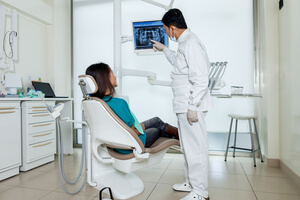

- Which type of oral abscess do I have?
- What treatment do you recommend?
- Are there any other options for treatment of the infection?
- How long will treatment take, and how many visits will I need?
- Will I need to take time off work to recover?
- How often should I come for check-ups in future?
- What oral care products do you recommend?
In some cases, damaged teeth become discoloured over time. You may want to ask your dentist how likely this is in your case, and what tooth whitening options may be available if you do experience tooth discolouration.
Gum abscess home treatment
Although the only way to be sure of effective treatment is with a visit to the dentist, there are some home remedies which can help alleviate the pain and stop the infection from spreading further while you wait for your appointment. So, how can you treat a tooth abscess at home?
The best form of tooth abscess pain relief is ibuprofen, but paracetamol is the second best. If you find just one of these ineffective, you may take both ibuprofen and paracetamol up to the maximum doses shown on the packets.
Other tooth abscess home remedies include:
- Rinsing and gargling with warm salt water
- Using topical pain relief gels, ointments and home remedies
- Avoiding hot or cold food and drink
- Eating only soft foods
- Avoiding flossing around the affected area
- Using a soft toothbrush
It's not possible to purchase antibiotics for tooth infection over-the-counter in the UK; they must be prescribed by a dentist.
If you don't seek professional treatment for your abscess, it is likely the infection will keep spreading. This can lead to serious damage to your teeth, periodontal ligament and jaw bone. The infection might even spread to other parts of your body via your bloodstream if left for long enough.
Remember that just because an abscess has burst or drained and the pain has subsided, this doesn't mean the infection is gone. You still need to visit a dentist.
How to prevent tooth and gum abscesses
Maintaining good oral hygiene and brushing your teeth correctly will minimise your chances of developing an abscess in your tooth or gum. There are many steps you can take to keep your teeth and gums as healthy as possible:
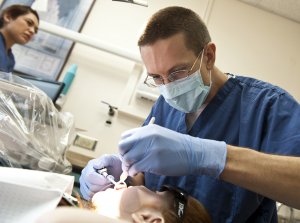

- Brush twice a day with fluoride toothpaste and floss or use an interdental brush at least once a day
- Avoid consuming sugary drinks and foods as snacks between meals or just before going to bed
- Where possible, brush soon after consuming foods and drinks with a high sugar or starch content
- Regularly visit your dentist to have oral check-ups
Even if you do develop dental cavities because of tooth decay, the affected tooth or teeth can be treated with a filling before the tooth pulp becomes infected.
This is far preferable to undergoing root canal treatment or extraction for an abscessed tooth, so regular trips to the dentist are very important.
If you still have your wisdom teeth, especially if they haven't emerged properly, speak to your dentist about whether it would be wise to have them removed.
Since wisdom tooth abscesses are relatively common, having the teeth removed is often the best way to prevent infections and other complications.
Finally, you should seek dental care if you experience any trauma to your teeth, for example, chipping or cracking. Even if there is no immediate pain, bacteria can invade the tooth immediately and a dental infection may develop within days.
Conclusion
Now you know more about what a tooth abscess is, some symptoms to look for, and how to know if a mouth infection has spread. You also know a bit about abscessed tooth treatment options, and the importance of seeing a dentist so they can clean the infected tissue and prescribe antibiotics if needed.
So, if you notice a painful pimple on your gum, the taste of pus in your mouth, or any other tooth infection symptoms, you should make sure to see your dentist. An abscessed tooth is serious and often stems from a problem like tooth decay. Additionally, if your tooth abscess pain is so severe that you can't eat, you should consider it a dental emergency.
FAQs
What does an abscessed tooth feel like?
Tooth abscess pain can vary from mild toothache to feeling like the side of your face is going to fall off. But in some cases, an abscess may not cause any pain at all.
Will a gum abscess go away on its own?
A tooth abscess can burst on its own but this doesn't mean the infection is gone. An abscess might originate at the root of your tooth or deep inside your gum pocket.
Can you drink alcohol with an abscessed tooth?
Drinking alcohol is unlikely to make your tooth infection worse, but it won't help heal it either. Abscessed teeth may be more sensitive to cold or acidic drinks too.


How do you drain a tooth abscess at home?
It may be tempting to try and pop a gum boil by yourself, but this is not something we recommend as you may make it worse by exposing the wound to other bacteria.
What's the best home remedy for a tooth abscess?
You can take painkillers or use topical oral pain relief to lessen tooth abscess pain. Natural home remedies like clove oil and a saltwater rinse can also help.
Can you die from a gum abscess?
In very rare cases, an oral abscess can be fatal. This is because if the infection is left untreated, it can spread to neighbouring tissues causing a condition called “Ludwig's Angina”.
Can popping a gum abscess kill you?
Popping a gum abscess itself is unlikely to be life-threatening, but it is important to seek professional dental care to prevent complications and ensure proper treatment.
What are the symptoms of a tooth infection spreading to the body?
Signs of a tooth infection spreading include feeling generally unwell, headache, fever, swelling, increased heart rate, difficulty breathing, dehydration and stomach pain.
My tooth abscess popped, what do I do?
If you pop an abscess, or it pops by itself, it may feel better for a while. However, that doesn't mean all the infection is gone. Visit a dentist to have it properly treated.
National Center for Biotechnology Information: Dental abscess: A microbiological review. Consulted 13th June 2023.
Great Ormond Street Hospital for Children NHS Foundation Trust – Gosh: Tooth abscess. Consulted 13th June 2023.
National Center for Biotechnology Information: Dental Abscess. Consulted 13th June 2023.
Nidirect: Dental abscess. Consulted 13th June 2023.





